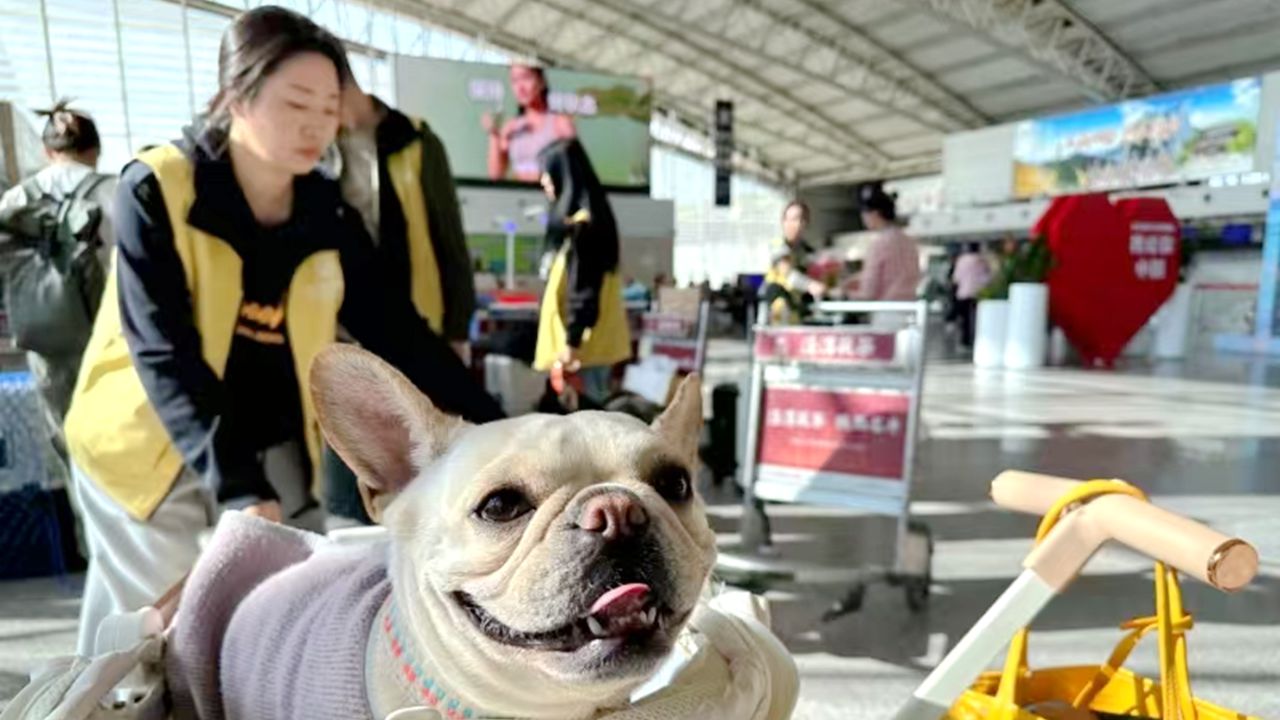Chinese airlines welcome 'paw-sengers'
Writer: | Editor: Zhang Zhiqing | From: | Updated: 2025-02-10
On a crisp winter morning, a French bulldog named Da Vinci touched down at East China’s Shanghai Hongqiao International Airport alongside his owner surnamed Liu, after a 2.5-hour flight from Guangzhou in South China. For the first time, the energetic puppy didn't have to endure the stress of cargo-hold travel.
Instead, it sat comfortably in a designated pet seat beside its human companion. “It costs an extra 1,000 yuan (US$139.48), about the same as a child’s ticket, but having him aside made the trip much happier,” Liu said.
Da Vinci’s journey reflects a growing trend in China’s aviation sector, as airlines and airports are moving to cater to the country’s ballooning pet-owner community.

A pet dog prepares to board a pet charter flight operated by Hainan Airlines from northwest China's Xi'an to the southern city of Sanya On Dec. 15, 2024, at Xi'an Xianyang International Airport. Photo from Xinhua
This year’s Spring Festival travel rush, which began Jan. 14, saw China Southern Airlines launch its upgraded “Pets in Cabin” service on select routes, including the round flights between Guangzhou and Shanghai.
For an additional fee, passengers can reserve exclusive pet seats. Each flight accommodates up to two small cats or dogs in the cabin. During the first week of the holiday season, the airline transported over 400 pets departing from Guangzhou — with around 35% of flying pets opting for dedicated pet seats.
Hainan Airlines, a pioneer in pet-in-cabin services since 2018, resumed its “Pet in Cabin” program in 2022 after a pandemic-induced pause. By November 2024, the carrier had transported more than 10,000 pets in-cabin across trips involving 27 major cities, including Beijing, Shanghai and Shenzhen.
Its subsidiary, Lucky Air, introduced similar services in May 2024. Strict protocols ensure hygiene and safety as pets must wear clothing, muzzles and diapers — and are required to remain in carriers during flights.
While in-cabin services flourish, airlines are also competing to improve traditional “live pet cargo” experiences.
In 2018, Sichuan Airlines debuted “Pet Airfare,” a premium service featuring climate-controlled holding areas, GPS tracking and door-to-door transportation.
Meanwhile, Shenzhen Bao’an International Airport opened China’s first dedicated pet lounge last year — a spacious facility equipped with air quality monitors, species-specific zones and play areas, where the traveling pets can wait for boarding.
“When I had to send my husky, Qiqi, back to Hebei, the staff fed her, took her on walks, and let us video chat during the waiting time. It was a huge relief,” said its owner surnamed Zhang.
According to an industry white paper, the value of China’s urban pet (dog and cat) sector reached 300.2 billion yuan in 2024, up 7.5% year-on-year. China’s total pet population surpassed 120 million.
Owners increasingly prioritize professional services, cleanliness and digital convenience — trends that airlines and airports are eager to tap.
Notably, nationwide sales of pet travel carriers, collapsible bowls, noise-reducing muzzles and GPS trackers have skyrocketed. (Xinhua)